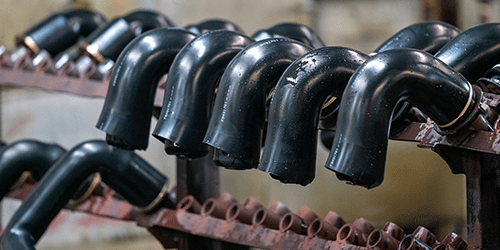Rubber is a critical material to modern civilization with numerous applications that surrounds us almost everywhere. Modern transportation is the most notable example of rubber usage which relies upon tires made of rubber for propulsion.
In the engineering terms, rubber is defined as a material that’s capable of stretching to a minimum 100 percent of its total length and returning to its original length and shape without undergoing permanent deformation. Rubber is capable of serving several engineering purposes. The wide arrays of applications where rubber can be used are grouped into these functional categories:
Although several other options can be employed by engineers to achieve the purposes listed above, use of rubber occurs more often as it offers lower cost, greater elegance and higher flexibility over other alternatives. Moreover, engineers can mold rubber into extremely complex configurations. Rubber can also be easily bonded with substrate materials to create a solid composite component, thereby enhancing the ability of an engineer to tailor functions of a component.
Many engineers know very little about rubber. One reason for that is the complexity of the material. Rubber is one of the most complex materials out there and it is this very complex nature of the rubber that makes it so flexible. The first complexity about rubber is its molecular nature: of all the substances out there, rubber polymers hold the longest chain length and higher molecular weight. The sheer length and size of the rubber molecules allow them to flow with freedom. This microscopic level of movement translates into large deflections that are ten times higher than other materials.
The second complexity is associated with rubber formulations which are mixtures of different ingredients. These mixtures are more complex than any other engineering material. For example, all metals are typically alloyed from two to four elements while plastics are mostly blends of three or four materials. However, rubber formulation typically composes of ten to twenty ingredients.
When a rubber is being selected for an application, it’s critical for engineers to understand the variety of available options. Rubber has many different polymer families, each with their own strengths and weaknesses. A few rubber polymers are great at resisting aggressive fluids but offer very little flexibility at low temperature. Some offer excellent performance at both high and low temperatures, but have little durability.
The variety of polymers offers an engineer a plethora of possibilities. For engineers, the challenge is to determine the option that would be best fit for their specific application. When they are looking to optimize a specific application, engineers should define the goals for rubber component. Will the rubber be used for sealing fluids? Will it be required for storing energy and releasing it when required? Is the rubber there for structural support?
In many applications, multiple actions are required and one of the best things about rubber is that it can address several needs in one compact package. That’s why rubber is an ideal choice for engineers.
If you’re looking for a quality rubber manufacturer that is able to meet your needs, contact us at Sperry Rice today!
